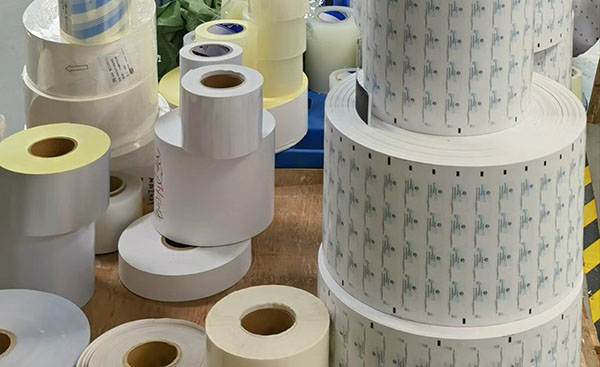Types of labels and anticounterfeit printing techniques
September 26, 2024
Types of Labels and Their Applications
(1) Definition of Labels and Classification of Label Materials
Labels are tools used to categorize or describe the content of a target, making it easier for oneself or others to find and locate specific items. Labels are ubiquitous in our daily lives and are used to indicate product names, identifiers, materials, manufacturers, production dates, and other important information. The printing quality of labels significantly impacts a product’s value, sales, and usage.
Labels are classified into several types, such as self-adhesive labels, in-mold labels, wet glue labels, heat-shrink film labels, sleeve labels, electronic labels, smart labels, and specialty labels.
Among these, self-adhesive labels and in-mold labels are the most common and widely used in the market, with each type emphasizing different printing techniques.
(2) The Role of Label Printing in China's Printing Industry
Label printing is considered the “high art” of the printing industry, embodying the essence of printing technology. Many new technologies, devices, and materials are applied in the label industry, making labels indispensable components of packaging and other products. Therefore, label printing holds a highly significant position within the broader printing industry.
(3) Classification and Market Applications of Self-Adhesive Labels
1. Classification of Self-Adhesive Labels
There are various methods for classifying self-adhesive label materials. They can be categorized by adhesive characteristics, adhesive coating technology, chemical properties of the adhesive, the properties of the face material, and the characteristics of the backing paper.
In the label industry, the most common methods of classification are based on the properties of the face material and the form of packaging:
- By face material characteristics: This includes paper-based self-adhesive labels, film-based self-adhesive labels, and specialty self-adhesive labels.
- By packaging format: Labels are available in rolls and sheets.
2. Market Applications for Self-Adhesive Labels
Self-adhesive labels are widely used across many industries, including:
- Personal and household care products: such as cosmetics.
- Food, fruits, beverages, and alcohol.
- Pharmaceuticals and medical devices.
- Electronics, electrical appliances, and batteries.
- Anti-counterfeiting labels and electronic supervision codes.
- Supermarkets, logistics, express delivery, and office supplies.
- Clothing, footwear, tags, and luggage labels.
- Tires, oils, and chemicals.
- Retail and smart label products.
- Other miscellaneous applications.
(4) Classification and Applications of In-Mold Labels
1. Two Major Types of In-Mold Labels
- (1) Blow molding in-mold labels
- (2) Injection molding in-mold labels
2. Applications of In-Mold Labels in the Market
- (1) Main applications of blow molding in-mold labels:
- Personal and household care products: such as labels for detergents, cleaners, bleaches, body wash, and cosmetics.
- Food and beverages: such as labels for edible oils, condiments, beverages, and juices.
- Lubricants: such as labels for lubricating oils, gear oils, and antifreeze products.
- Pharmaceuticals: high-end pharmaceutical labels.
- (2) Main applications of injection molding in-mold labels:
- Food packaging containers: such as labels for ice cream and salad dressing.
- Plastic containers, children's toys, and stationery.
- Labels for some electrical appliance panels.
As in-mold labeling technology becomes more widespread and production costs decrease, its application scope continues to expand.
Anti-Counterfeit Printing Techniques for Self-Adhesive Label Security Marks
1. Multi-Color Blended Printing
Multi-color blended printing, also known as blended color packaging printing, often uses relief printing presses for packaging. This technique involves placing dividers in the ink fountain and adding different colors of ink to separate sections. As the ink rollers blend the adjacent inks, the mixed colors are transferred to the printing plate. This method allows multiple colors to be printed in one pass, creating soft transitions between colors. Since it is difficult to see the exact placement of the ink fountain dividers on the print, this technique also provides a certain level of anti-counterfeit protection. When used for large-scale background printing, it enhances the security features.
2. Intaglio Printing
Intaglio printing refers to a technique where the image areas on the printing plate are raised, and the printed image is also embossed with raised ink, making the lines and details sharp and distinct, which can be felt by touch. This method not only protects the paper but also adds anti-counterfeiting features. Key securities often use intaglio printing. Intaglio printing plates are classified into two types based on how they are made: engraved plates (which include hand-engraved and mechanically engraved plates) and etched plates. Hand-engraved intaglio printing provides excellent anti-counterfeiting protection.
When combined with anti-counterfeit ink, the effect is enhanced. Some anti-counterfeit inks have large pigment particles and require thicker ink layers, which pair well with the texture of intaglio printing. Together, they create multiple layers of anti-counterfeit and decorative effects. For example, when intaglio printing uses fluorescent ink, it maintains the raised texture of intaglio printing while meeting the requirements of fluorescent ink, ensuring strong anti-counterfeit protection from both techniques.
3. Laser Holographic Retinal Printing
Laser holographic retinal printing uses holographic lens technology to create a master plate in a vibration-proof chamber. The pattern is then transferred onto a substrate under specific pressure. When viewed under a 45-degree light source, the product exhibits a colorful, starry sky effect with a strong sense of depth and texture, making it popular with customers. Some refer to it as the 21st-century color printing method without ink. Currently, two common techniques are used: cold pressing and coating, or directly hot stamping with holographic film.
Due to the complexity of the plate-making process and the difficulty of production, only a few manufacturers in China can produce these holograms, making them highly effective for anti-counterfeiting. It's important to note that hologram imaging is captured in a vibration-free room using laser light, where the image is encoded with both amplitude and position information at a nanoscopic level. This relies on the principle of light interference to construct the image from every tiny particle of information. Even the slightest air movement during the plate-making process can alter the colors of the hologram, making it impossible to produce two identical holograms.
4. Hand-Engraved Embossing Plates
Many packaging and promotional prints require key product names or images to be embossed. This raised effect is typically achieved using chemical etching to create a relief plate, which is then combined with plaster for embossing. Although this method is simple, quick, and easy to produce, the raised effect is often not strong, and it lacks anti-counterfeit features. Therefore, many printing companies now use hand-engraved embossing techniques, which provide a much more defined and effective result.
Superb Victory Packaging specializes in producing a wide range of labels, tailored to meet your specific needs. Whether you're looking for adhesive labels, anti-counterfeiting labels, or specialty options, our high-quality printing and materials ensure durability and precision. From personal care products and food packaging to electronics and pharmaceuticals, our labels are designed for various industries. Contact us today to customize the perfect label solution for your products!








